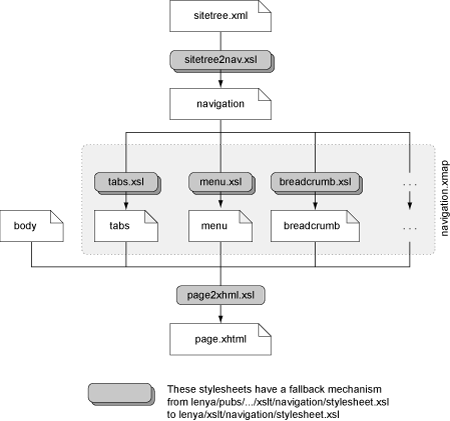The Navigation Framework
Table of Contents
Introduction
To goal of the navigation framework is to
- simplify and standardize the generation of navigation widgets like menubars, tabs, breadcrumb paths.
With the approach that is presented here it shall be possible to
- use pre-defined XHTML navigation components and present them with a custom CSS,
- override these components in a publication whereby the logic can be reused, and
- create and integrate new publication-specific navigation components using the same scheme.
Architecture
The navigation framework consists of the following components:
-
/lenya/navigation.xmap - The sitemap where the navigation components are loaded.
-
/lenya/xslt/navigation/*.xsl - The default navigation components that are shipped with Lenya.
-
/lenya/pubs/lenya/xslt/navigation/*.xsl - Custom navigation components of the publication.
Using the Navigation Framework
Loading a Navigation Component
You can load a navigation component from the following URI:
cocoon://navigation/<pub-id>/<component>/<path>.xml
The URI steps are:
-
<pub-id> - The publicaton ID.
-
<component> - The navigation component to load (tabs, menu, etc.).
-
<path> - The navigation path. It is a concatenation of the
hrefattributes of the sitetree nodes that lead to the current node, e.g.demo/oscom.htmlfor the sitetree fragment
<site xmlns="http://apache.org/cocoon/lenya/sitetree/1.0">
<node href="demo/" label="Demo">
<node href="oscom.html" label="OSCOM"/>
...
</node>
...
</site>
Aggregating the Navigation Components
The basic principle is shown in the following figure:

In the publication sitemap (lenya/pubs/<pub-id>/sitemap.xmap)
the navigation components are aggregated. Here you decide which components
you want to use:
<map:pipeline>
<map:match pattern="navigation/**.html">
(1) <map:aggregate element="page" prefix="page"
ns="http://apache.org/cocoon/lenya/cms-page/1.0">
(2) <map:part src="cocoon://navigation/
{publication-id}/breadcrumb/{../1}.html.xml"/>
(3) <map:part src="cocoon://navigation/
{publication-id}/tabs/{../1}.html.xml"/>
(4) <map:part src="cocoon://navigation/
{publication-id}/menu/{../1}.html.xml"/>
</map:aggregate>
(5) <map:transform src="xslt/page2xhtml.xsl">
(6) <map:parameter name="root"
value="{context}/{publication-id}/"/>
</map:transform>
(7) <map:serialize type="xhtml"/>
</map:match>
</map:pipeline>
- The navigation elements are aggregated together with other document parts.
- Load the breadcrumb XHTML fragment.
- Load the tabs XHTML fragment.
- Load the menu XHTML fragment.
- Create the XHTML page.
- The stylesheet can use this parameter to generate absolute URLs.
- Finally, serialize the page as XHTML.
Developing Navigation Components
The following contracts define the development of navigation components:
- A navigation component is an XSLT stylesheet that is located at
-
lenya/xslt/navigation/<component>.xsl - for default components and
-
lenya/pubs/<publication-id>/lenya/xslt/<component>.xsl - for default components.
-
- The default components produce an XHTML fragment with the top level element <div class="<component>"/>.


